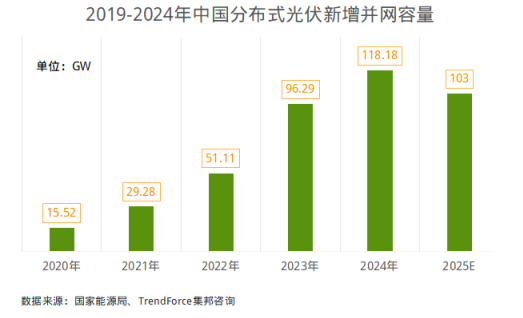TrendForce, in a published article, stated that data shows that by the end of 2024, the cumulative installed capacity of national solar power reached 886.66 GW, with new installations reaching 277.17 GW, once again setting a new historical record. The release of this data signifies that China's photovoltaic (PV) industry has entered a new development phase. However, the construction of distributed PV power stations often suffers from unstable component quality and high operation and maintenance costs, leading to fluctuations in return on investment. Against this backdrop, there is a gradual emergence of brand collaboration models in the market, as companies hope to address standardization issues at power stations through synergistic effects. For PV enterprises, how to leverage technological and model innovations to solve industry pain points and difficulties with efficient and high-quality products has become an extremely important topic for corporate development. Currently, the PV industry has shifted from "competing on scale" to "competing on quality" .
The "Anxiety" of Distributed PV
Currently, the PV industry is experiencing unprecedented technological and market changes, with new policies and market patterns continuously driving the industry towards high-quality development. In recent years, driven by policy incentives, advancements in PV technology, and demand growth, China's new installations of distributed PV have rapidly increased. In terms of scale, by the end of 2024, the cumulative installed capacity of distributed PV reached 370 GW, accounting for 42% of China's total PV installations. Regarding new installations in 2024, distributed PV added 120 GW, making up 43% of the year's new PV installations .
According to TrendForce, the market size for distributed PV will continue to expand in 2025, with expected new installations reaching 103 GW, exceeding 40% of the country's total new installations, indicating a promising outlook. Distributed PV power generation has become a significant force in energy transition, and in 2025, the distributed PV market will also enter a fiercely competitive phase .

As the industry rapidly develops, there are now large-scale existing distributed PV power stations, which raise higher demands for subsequent operation management systems and professional requirements. Behind the booming industry, issues such as absorption bottlenecks, technical risks, supply chain instability, unstable benefits, and operation and maintenance management are gradually surfacing, hindering further development.
Currently, PV technology remains in a constant state of innovation, with companies striving to make breakthroughs and continuously incorporate new technologies into their products. While adopting new technologies can bring about higher product benefits, it also comes with the risk of insufficient technological maturity, making it difficult to assess the reliability and stability of component products over time .
It is well understood that the long-term operation of PV projects relies on quality-reliable components and equipment, thus necessitating the establishment of an effective quality management system. Quality control of components and long-term operation and maintenance management directly affect the long-term operational benefits of projects, involving cost control and ultimate project returns. Additionally, PV projects involve numerous suppliers and materials, with supply chain management including ensuring material quality, delivery times, and managing material price fluctuations, presenting certain complexities .
With the increasing proportion of distributed energy in the renewable energy mix, the construction of distributed PV power stations frequently faces challenges such as unstable component quality and high operation and maintenance costs, leading to fluctuations in return on investment. In response, brand collaboration models are emerging in the market, as companies aim to resolve standardization issues at power stations through synergistic effects .
For PV enterprises, solving these challenges and achieving sustainable development requires not only technological and model innovations but also the ability to effectively integrate resources across the upstream and downstream sectors of the PV industry. This collaborative approach is essential for tackling the complexities of distributed PV and ensuring long-term success in the evolving landscape of renewable energy .
Contact: Shi Xuechun
Phone: 15312161816
E-mail: xuechun.shi@wgp-js.com
Add: C3 Building,159 Mudan Rd. Rudong Economic Development Zone,Rudong 226400 P.R.China